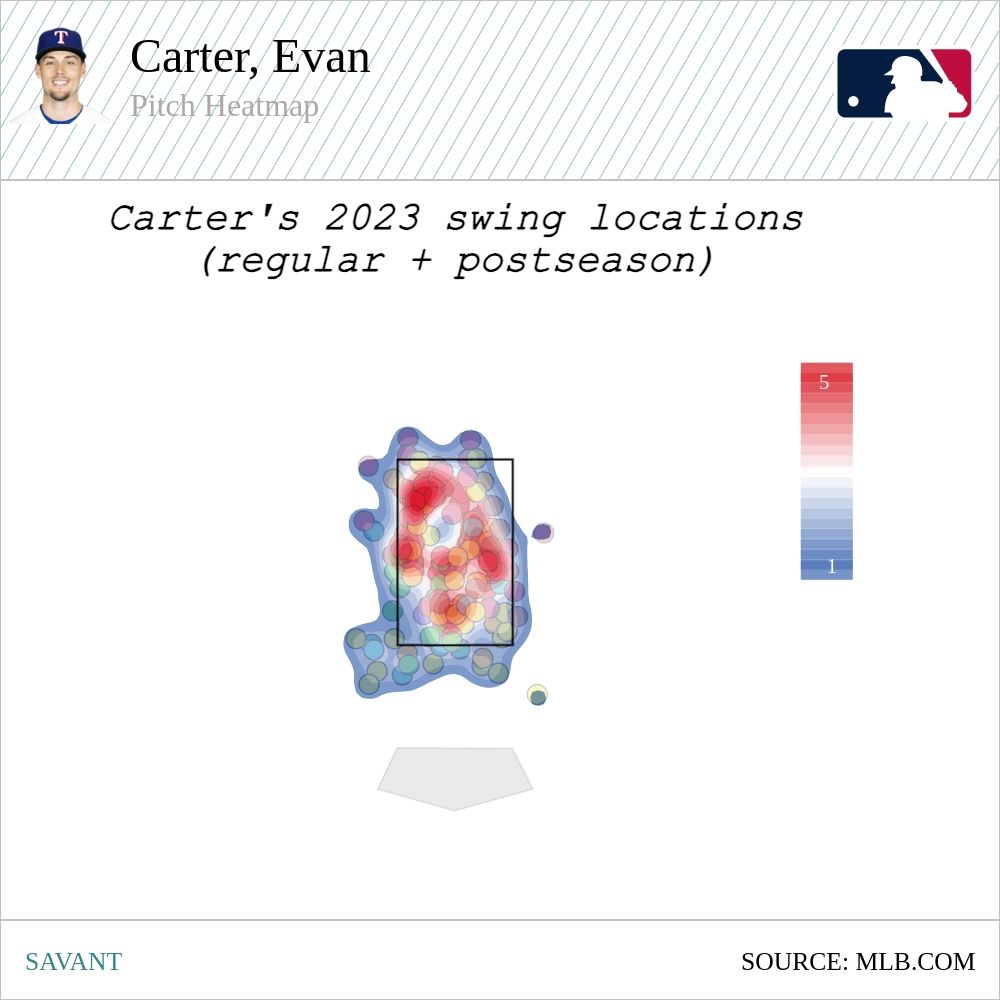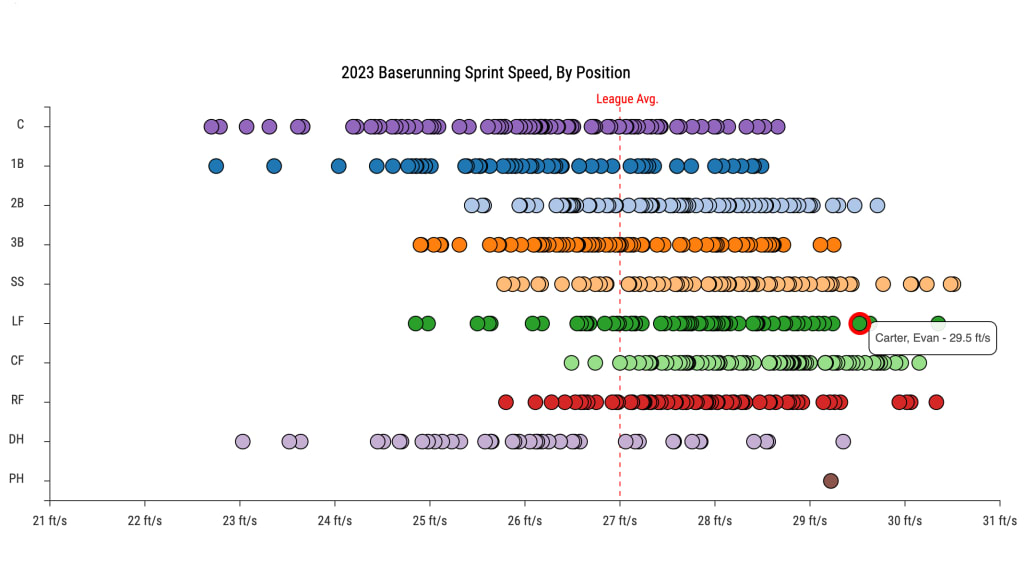One of the biggest stars of the playoffs, for any team, is a 21-year-old rookie who only got 23 big league games under his belt before the Rangers threw him into their postseason starting lineup.
Evan Carter is that talented. MLB's No. 8 overall prospect isn't just earning his spot, he's stealing the show.
It only took two games in Texas' Wild Card Series sweep of the Rays for Carter to put all his tools on display. And Carter -- who just reached the one-month anniversary of his big league promotion -- has only kept doing it in the American League Division Series against the Orioles.
Here are five ways Carter has already shown he can impact a postseason game.
1) His power
In his postseason debut, Game 1 of the Wild Card Series, Carter did everything but homer. We'll get to that in a second. Because in his follow-up in the Rangers' clinching Game 2 win, he did homer. So let's look at his biggest swing first.
Carter's home run off Zach Eflin wasn't a monster blast; it was more of a prototypical home run, 102.5 mph off the bat at a 24-degree launch angle, traveling a Statcast-projected 391 feet to right field. But look at Carter's swing. Look how free and easy his power is.
Carter's stance is so relaxed. His swing has so little wasted movement, meeting the pitch on plane -- Carter's attack angle against Eflin's cutter up in the zone was 6 degrees, reflecting a level swing against an elevated pitch. There's no hint of tension in Carter's swing, but that swing can still easily put the ball over the fence.
In the regular season, Carter barreled 10.3% of his batted balls -- meaning, essentially, that he drove them hard enough and in the ideal angle to be a home run or an extra-base hit -- and any barrel rate in double digits shows solid power. In other words, his Wild Card homer, and any other home runs he might connect on in these playoffs, aren't coming out of nowhere.
2) His contact hitting
Carter is batting .500 through his first four career postseason games, with five hits in 10 at-bats. He has three doubles on top of his Wild Card Series home run. Those other base hits show you Carter's bat-to-ball skill and plate coverage.
His first double, in Game 1 of the Wild Card Series, came against a 97 mph Tyler Glasnow fastball on the outside edge of the plate, which Carter calmly stroked into the right-center-field gap.
His second double, later in that game, came with two strikes in a lefty-lefty matchup against sidewinding reliever Jake Diekman. Diekman threw Carter a 95 mph fastball on the inside edge of the plate, but Carter got his hands through and slapped a ground ball down the first-base line, off the glove of a diving Yandy Díaz.
And his third double, in Game 1 of the ALDS, was off an 88 mph Kyle Bradish slider on the bottom edge of the zone, which he roped at 101.5 mph off the bat into the right-field corner. Bradish's slider was one of the most effective pitches in baseball this season -- opponents batted just .168 and slugged .272 against it in 214 plate appearances.
Carter has shown the ability to cover all areas of the zone, against both righties and lefties, against ace starters and specialist relievers. He's been contact-hitting since his callup, too, with a 46.2% hard-hit rate and 43.6% launch angle sweet-spot rate during the regular season -- that's just a fancy way of saying Carter squares up the baseball, and sprays lots of line drives. When you do that, you get hits.
3) His discipline
But maybe the most impressive thing about Carter's playoff run so far is this: He's actually collected more walks than he has hits. Carter has drawn six walks -- with only two strikeouts. And that's really the key to his whole approach at the plate.
Carter is a highly selective hitter. Between the regular season and postseason, he's only swung at 34.5% of the pitches he's seen in the big leagues, the lowest swing rate of any hitter who's seen at least 400 pitches this year.
And he's only chased a minuscule 9.4% of pitches outside the strike zone, the lowest chase rate of the 457 hitters who've seen at least 200 out-of-zone pitches.
Lowest chase rate, 2023 (incl. postseason)
Min. 200 out-of-zone pitches seen
- Evan Carter: 9.4%
- Edouard Julien: 14.2%
- Davis Schneider: 15.7%
- Cavan Biggio: 16.0%
- Robbie Grossman/Travis Jankowski: 16.1%

The Rangers chase the fewest pitches of any team in baseball, and Carter chases the fewest pitches of any Ranger. That's how he's produced a Juan Soto-esque 19.6% walk rate through 92 plate appearances. It's a small sample, but that's a higher walk rate than any other hitter this season -- Carter's postseason walks have pushed him ahead of the aforementioned Soto and Aaron Judge.
4) His glove
Oh yeah, Carter also made a highlight-reel catch in his very first postseason inning.
Carter tracked Isaac Paredes' line drive down the left-field line and made an inning-ending, potentially run-saving diving catch. His catch probability on the play was just 45%, per Statcast.
He needed to cover 59 feet in just 3.8 seconds to make the play, and he got a great read on the ball to do it.
Carter is already showing excellent outfield instincts and range. Even with only a handful of games in left field, he's already been worth +2 Outs Above Average this season.
5) His speed
Last one and then we're done. Carter's got speed.
The best postseason example so far is his hustle double off Diekman and the Rays, when Carter reached a sprint speed of 29.0 ft/sec to make it to second as the ball caromed off Díaz's glove into short right field.
But there are more from the ALDS: Carter going first-to-third on a Jonah Heim single in Sunday's Game 2, also at 29.0 ft/sec … Carter easily staying out of a double play with a 30.0 ft/sec sprint speed down the line just before that Heim base hit … Carter nearly winning a footrace to first base with O's pitcher DL Hall in Game 1 at 30.2 ft/sec.
Major League average sprint speed is 27 ft/sec; 30-plus ft/sec is elite speed.
Carter's average sprint speed this season is close to that elite range: 29.5 ft/sec. He's in the 96th percentile of all MLB players when it comes to speed, and he's one of the fastest left fielders in baseball.

That speed can come into play via taking the extra base or via stolen bases -- Carter had one steal in the Wild Card Series, and three in the regular season without being caught. Just one more way he can impact the 2023 playoffs.
